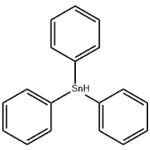TRIPHENYLTIN HYDRIDE manufacturers
- TRIPHENYLTIN HYDRIDE
-

- $8.00 / 1kg
-
2024-04-25
- CAS:892-20-6
- Min. Order: 1kg
- Purity: 99%
- Supply Ability: g-kg-tons, free sample is available
|
| | TRIPHENYLTIN HYDRIDE Basic information |
| | TRIPHENYLTIN HYDRIDE Chemical Properties |
| Melting point | 28 °C (lit.) | | Boiling point | 163-165 °C/0.3 mmHg (lit.) | | density | 1.374 g/mL at 25 °C (lit.) | | refractive index | n20/D 1.632(lit.) | | Fp | >230 °F | | storage temp. | 2-8°C | | form | solid | | Specific Gravity | 1.374 | | Water Solubility | Insoluble in water. | | Hydrolytic Sensitivity | 8: reacts rapidly with moisture, water, protic solvents | | Sensitive | Moisture Sensitive | | BRN | 3544353 | | Exposure limits | ACGIH: TWA 0.1 mg/m3; STEL 0.2 mg/m3 (Skin)
NIOSH: IDLH 25 mg/m3; TWA 0.1 mg/m3 | | CAS DataBase Reference | 892-20-6(CAS DataBase Reference) | | EPA Substance Registry System | Triphenyltin (892-20-6) |
| | TRIPHENYLTIN HYDRIDE Usage And Synthesis |
| Chemical Properties |
opalescent colorless or milky white to pale yellow. Soluble in many common organic solvents; usually used in benzene or toluene.
| | Uses | Although the
triphenyltins exhibit some curative effect, they are used
mainly as protectants for control of a range of diseases,
examples being early and late blights of potato and leaf
spots on sugar beet and peanut. | | Reactivity Profile |
Triphenylstannane could be used in the reactions:
Generation of carbon radicals from selenides, halides, sulfides, and alkynes; radical deoxygenation; reduction of α,β- unsaturated aldehydes and ketones; hydrostannylation of alkynes and alkenes; reversible addition of stannyl radicals to double bonds; formation of metal triphenylstannates; reduction of aldehydes and ketones; desulfonation of β-keto phenyl sulfones; hole-transfer-promoted hydrogenation.
| | reaction suitability | reagent type: reductant | | Synthesis |
The Preparative Method of Triphenylstannane: reduction of Chlorotriphenylstannane with Lithium Aluminum Hydride in ether or with Sodium Borohydride in glyme; reduction of bis(triphenyltin) oxide with polymethylhydrosiloxane; reduction of triphenyltin methoxide with diborane; protonation of Ph3SnLi. The reagent was also generated in situ from Ph3SnCl and Sodium Cyanoborohydride in t-butyl alcohol.
| | Precautions | Triphenylstannane (Ph3SnH) can be stored for several months and is easily repurified by Kugelrohr distillation (oil-pump vacuum) before use. Organotin hydrides decompose slowly at rt and are best stored at 0 °C or below.
|
| | TRIPHENYLTIN HYDRIDE Preparation Products And Raw materials |
|